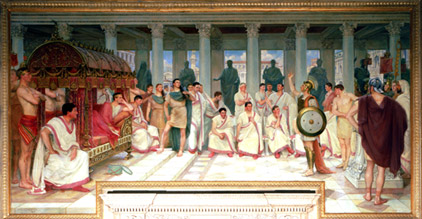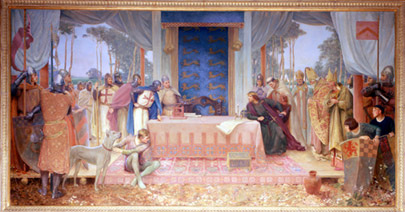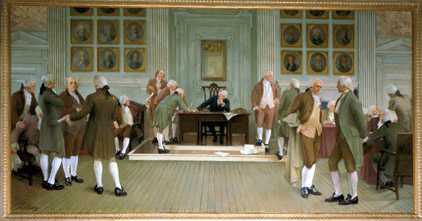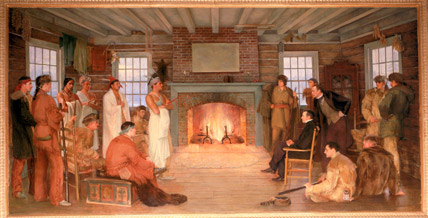Visiting the Supreme Court
The Wisconsin Supreme Court Hearing Room is located in the State Capitol Building (external link) in Madison. Visitors are welcome to view the hearing room and attend the Court's proceedings that are held there. (View a detailed diagram of the hearing room.)
A special program called Court with Class arranges for high school classes from throughout the state to attend oral arguments and meet with a justice during the lunch hour. For more information about the program, email the Court Information Office.
History behind the hearing room
Written by Roland B. Day, Chief Justice (retired), Wisconsin Supreme Court / Chair, Wisconsin Bicentennial Committee on the U.S. Constitution, 1986-1991
The Wisconsin Supreme Court Hearing Room is reputed to be the most beautiful of its kind in the country. In addition to the walls and columns of marble from Germany, Italy, France and Maryland, the bronze candelabras, the carved mahogany bench and counsel table, the most striking objects are the four large murals, each nine feet by 18 feet six inches. Each mural depicts a source of Wisconsin law.
Albert Herter (1871-1950), the famous New York muralist, was commissioned to paint the murals. They were painted in New York and later installed in the hearing room. Of special note is the way the colors in the murals complement the colors in the marble panels beneath them.
 The mural over the entrance to the Hearing Room depicts an incident in the reign of Caesar Augustus Octavius. The Roman writer Seutonious tells of Scutarious, a Roman legionnaire who was being tried for an offense before the judges seated in the background. The legionnaire called on Caesar to represent him, saying: "I fought for you when you needed me, now I need you." Caesar responded by agreeing to represent Scutarious. Caesar is shown reclining on his litter borne by his servants. Seutonious does not tell us the outcome of the trial but leaves us to surmise that with such a counselor he undoubtedly prevailed.
The mural over the entrance to the Hearing Room depicts an incident in the reign of Caesar Augustus Octavius. The Roman writer Seutonious tells of Scutarious, a Roman legionnaire who was being tried for an offense before the judges seated in the background. The legionnaire called on Caesar to represent him, saying: "I fought for you when you needed me, now I need you." Caesar responded by agreeing to represent Scutarious. Caesar is shown reclining on his litter borne by his servants. Seutonious does not tell us the outcome of the trial but leaves us to surmise that with such a counselor he undoubtedly prevailed.
The mural represents Roman civil law, which is set forth in codes or statutes, in contrast to English common law, which is based not on a written code but on ancient customs and usages and the judgments and decrees of the courts which follow such customs and usages.
Today we are governed by our own common law as well as by codes in the form of statutes passed by the legislature which may change or add to the common law.
 The mural on the left of the Hearing Room shows King John of England (1166-1216) sealing and granting Magna Charta (the Great Charter) in June 1215 on the banks of the Thames River at the meadow called Runnymeade. His reluctance to grant the Charter is shown by his posture and sullen countenance. But he had no choice. The barons and churchmen led by Stephen Langton, Archbishop of Canterbury, forced him to recognize principles that have developed into the liberties we enjoy today. King John, out of avarice, greed or revenge, had in the past seized the lands of noblemen, destroyed their castles and imprisoned them without legal cause. As a result, the noblemen united against the king.
The mural on the left of the Hearing Room shows King John of England (1166-1216) sealing and granting Magna Charta (the Great Charter) in June 1215 on the banks of the Thames River at the meadow called Runnymeade. His reluctance to grant the Charter is shown by his posture and sullen countenance. But he had no choice. The barons and churchmen led by Stephen Langton, Archbishop of Canterbury, forced him to recognize principles that have developed into the liberties we enjoy today. King John, out of avarice, greed or revenge, had in the past seized the lands of noblemen, destroyed their castles and imprisoned them without legal cause. As a result, the noblemen united against the king.
Most of the articles in Magna Charta dealt with feudal tenures, but many other rights were also included. Article 39 provided: No freeman shall be seized or imprisoned, or dispossessed, or outlawed, or in any way destroyed, nor will we condemn him, nor will we commit him to prison, excepting by the legal judgment of his peers or by the law of the land.
Article 40 promised: To none will we sell, to none will we deny, to none will we delay right or justice.
Out of these and other provisions came the rights of habeas corpus and trial by jury. Freedom of the church was also guaranteed in the Charter. The barons and churchmen claimed that all of these were ancient rights expressed in earlier charters of Edward the Confessor (1004-1066) and Henry I (1100-1135). This mural commemorates our indebtedness to English common law, brought to these shores by the early British colonists.
The young boy holding the dog was modeled by Christian Herter (1895-1967), son of the artist. He became governor of Massachusetts and secretary of state under President Dwight D. Eisenhower.
 The mural above the bench is the signing of the United States Constitution on September 17, 1787, in Philadelphia. George Washington is shown presiding. On the left, Benjamin Franklin is easily recognizable. On the right, James Madison, "Father of the Constitution" is shown with his cloak on his arm. Although he was in France at the time, Thomas Jefferson was painted into the mural because of his great influence on the principles of the Constitution.
The mural above the bench is the signing of the United States Constitution on September 17, 1787, in Philadelphia. George Washington is shown presiding. On the left, Benjamin Franklin is easily recognizable. On the right, James Madison, "Father of the Constitution" is shown with his cloak on his arm. Although he was in France at the time, Thomas Jefferson was painted into the mural because of his great influence on the principles of the Constitution.
The mural's position above the bench is symbolic that the Supreme Court operates under its aegis and is subject to its constraints. The United States Constitution has served us well for more than 200 years. This mural shows our indebtedness to federal law.
 The mural on the right wall shows the trial of Chief Oshkosh of the Menominees for the slaying of a member of another tribe who had killed a Menominee in a hunting accident. It was shown that under Menominee custom, relatives of a slain member could kill his slayer. Judge James Duane Doty held that in this case territorial law did not apply:
The mural on the right wall shows the trial of Chief Oshkosh of the Menominees for the slaying of a member of another tribe who had killed a Menominee in a hunting accident. It was shown that under Menominee custom, relatives of a slain member could kill his slayer. Judge James Duane Doty held that in this case territorial law did not apply:
. . . it appears to me that it would be tyrannical and unjust to declare him, by implication, a malicious offender against rules which the same laws presume he could not have previously known...
Judge Doty acquitted Chief Oshkosh of the charge. They became friends.
In 1848 Wisconsin achieved statehood and this mural shows our indebtedness to territorial law. Article XIV of the Wisconsin Constitution of 1848 says the common law in force in the territory and the laws of the territory are part of the law of Wisconsin except as changed by the Constitution or altered or repeated by the legislature.
Thus the four murals show that Roman, English, federal and territorial law are all part of our legal heritage.
In 1836, when Wisconsin became a territory, Doty persuaded the legislature to move the capital from Belmont to the present site to be named Madison after the Father of the Constitution, James Madison. The streets around the Capitol were named after the 39 signers of that document. A watercolor in the Supreme Court reception area by William Dyke, a judge, attorney, artist and former Madison mayor, depicts the Supreme Court and Council House buildings at Belmont.
At the entrance to the Supreme Court Hearing Room are striking busts of two early and highly respected chief justices of this Court. On the left is Luther Swift Dixon, of Portage, who was chief justice of the Wisconsin Supreme Court from 1859 to 1874. On the right is Edward George Ryan, of Milwaukee, who was chief Justice from 1874 to 1880.
Luther Swift Dixon
Chief Justice Luther Swift Dixon was 34 years old and had been a lawyer for just nine years when the governor appointed him to replace the late Chief Justice Edward Vernon Whiton, of Janesville.
Born and raised in Vermont, Dixon traveled to Wisconsin and set up a law practice in Portage, which was a thriving frontier town because of its placement between the Fox and Wisconsin Rivers. Dixon was twice elected district attorney of Columbia County and was soon appointed judge of the ninth judicial circuit. He was described in the Wisconsin Bar Association Reports (July 1908, vol. 8) as being "approachable and companionable, and sociable, thoroughly likeable and of winning personality in every way".
Almost immediately upon joining the state's highest Court, however, Dixon found himself embroiled in controversy and targeted by the Republicans who wanted to see him defeated when he faced election.
The controversy stemmed from the Booth case, in which the Wisconsin Supreme Court (before Dixon joined the Court) unanimously declared unconstitutional the fugitive slave act, which required northern states to return runaway slaves to their masters. The U.S. Supreme Court overturned that decision and Wisconsin citizens were outraged.
When it came time to file the mandates from the U.S. Supreme Court, the task fell to Dixon and Justice Orsamus Cole. Cole, who did not believe the U.S. Supreme Court had the power to review judgments of the state Supreme Court, immediately took the position that the mandate upholding the fugitive slave act should not be filed in Wisconsin. Dixon, however, took the opposite view and thus became targeted by the Republicans who were strong believers in states' rights.
Then, as now, justices of the Wisconsin Supreme Court were elected in statewide races. The 1860 election was a heated one and it took two weeks to tabulate the results. During this time, both Dixon and his opponent claimed victory, and each side accused the other of tampering with votes. In the end, Dixon won his seat with less than 400 votes in a vote total of 116,000.
Dixon resigned after 15 years on the bench to return to the practice of law. It was said of him in a eulogy: "His decisions constitute a record imperishable and his enobling influence upon the body of our law will be felt and acknowledged . . . in the long future." Another said of him that he had "the sparkling wit . . . and keen sense of humor so often observable in great lawyers."
Edward George Ryan
Chief Justice Edward George Ryan was appointed to replace Dixon. His appointment surprised observers because he was already 64 years old, had no experience on the bench and was known to have a violent temper. Senator Vilas, in a eulogy, said of Ryan: "(His temper) made him terrible to his friends as well as his enemies; tyrannical, perhaps sometimes cruel . . . violent and hostile where he should have been friendly." Still, his abilities as a litigator, orator and judicial scholar were widely praised.
Justice John B. Winslow, in Story of a Great Court, his book about the early years of this Court, said of Ryan's six years as chief Justice: "[H]e not only dispelled the doubts which followed his appointment but added vastly to the standing and prestige of (the) Court . . . [H]is opinions on great questions left a monument to his memory more enduring than brass or marble."
Chief Justice Cole, shortly after Ryan's death, said of his reputation for a bad temper: "While engaged in the labor of considering and deciding causes, the deportment of the chief justice towards his associates was uniformly kind, respectful and courteous. No irritating word, no offensive language, fell from his lips while thus employed . . . he listened with attention to whatever anyone had to say adverse to his views and often came to their conclusion when it seemed supported by the better reason or authority".
Ryan was a religious man and had a deep reverence for law and order. After his death, a well-worn prayer written in his own hand was found among his effects. It read, in part, "Give me grace to bear patiently, to consider diligently, to understand rightly and to decide justly. Grant me due sense of humility, that I be not misled by my wilfulness, vanity or egotism."
Ryan was born in Ireland and emigrated to the United States at age 20. He studied law in New York, and moved to Chicago before settling in Racine and then Milwaukee. He is perhaps best known today for an opinion he wrote in 1875 (39 Wis. 232), when Lavinia Goodell became the first woman to request admission to the bar of the Wisconsin Supreme Court. She had previously been admitted to practice in the circuit court for Rock County.
Ryan denied the application, writing the following for the Court: "There are many employments in life not unfit for female character. The profession of the law is surely not one of these. The peculiar qualities of womanhood, its gentle graces, its sensibility, its tender susceptibility, its purity, its delicacy, its emotional impulses, its subordination of hard reason to sympathetic feeling, are surely not qualifications for forensic strife. Nature has tempered woman as little for the juridical conflicts of the court room, as for the physical conflicts of the battle field. Womanhood is moulded for gentler and better things".
Shortly after, the Wisconsin Legislature passed a bill to admit Goodell to the bar. When her application came before the Supreme Court again, although Ryan dissented, two justices agreed and she was admitted.
Both Dixon and Ryan, having died with very little money, were buried in unmarked graves. Then, in 1909, Justice Roujet D. Marshall of Chippewa Falls, began a campaign through the State Bar of Wisconsin to raise funds for monuments over each grave. Today, Dixon's grave (at Forest Hill Cemetery in Madison) and Ryan's grave (at Forest Home Cemetery in Milwaukee) are marked by tall, white granite obelisks, a fitting tribute to two men so different in temperament but both great jurists.
Partial list of sources
- William Blakstone, Commentaries on the Laws of England (Fourth Edition), (The Clarendon Press, Oxford, 1770).
- Catherine Cleary, Lavinia Goodell, First Woman Lawyer in Wisconsin, Wisconsin Magazine of History, Vol. 74, p. 243 (State Historical Society of Wisconsin, Madison, 1991).
- David V. Mollenhoff, Madison, A History of the Formative Years (Kendall and Hunt, Dubuque, Iowa, 1982).
- Alice Elizabeth Smith, James Duane Doty, Frontier Promoter (State Historical Society of Wisconsin, 1954.)
- Richard Thomson, An Historical Essay on the Magna Carta of King John, (Major and Jennings, London, 1829.)
- John Bradley Winslow, Story of a Great Court (T.H. Flood & Company, Chicago, 1912).
- Wisconsin State Capitol Guide and History, Bicentennial Issue (Thirteenth Edition) (State of Wisconsin Department of Administration, 1975).

